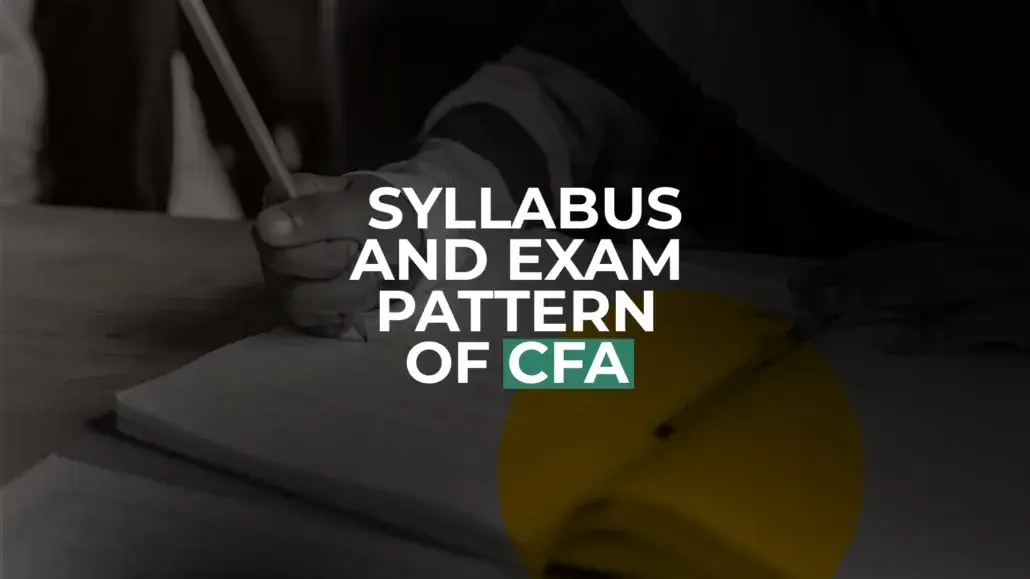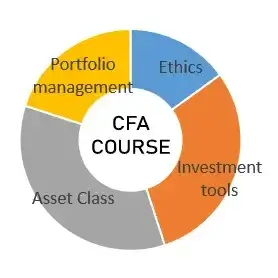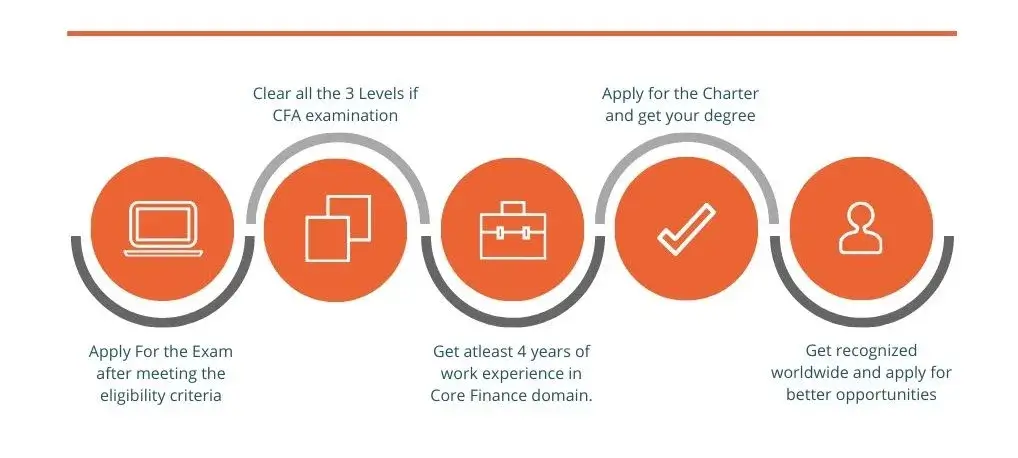A Comprehensive Guide To the Syllabus and Exam Pattern of CFA

Here's What We've Covered!
Completing the CFA program means you are eligible to work in a globally recognised role and a prestigious designation in national and multinational organisations. Students aiming to join a company in this role need to complete the CFA program and attain certification from the CFA Institute.
Within the program, there is a three-level exam every student needs to take. These exams will judge the students in different areas, including Financials, Accounting, Mathematical, Reporting, etc. Individuals can express their expansive knowledge and build their value in an evolving and competitive industry by completing these exams. Follow the CFA exam pattern and guide to understand who can give the CFA exam and the exam syllabus, pattern, & structure.
The Basic Eligibility Criteria for CFA
Before heading into the CFA exam pattern, let’s find out who and who cannot take part in the CFA program. The eligibility criteria is set to ensure that only students with prior knowledge, experience, and understanding of the subject matter are allowed to participate.
The eligibility criteria are as follows;
- The candidates must have completed their bachelor’s degree in Commerce stream or obtained an equivalent degree from a recognised institution or university.
- Students in the final year of their bachelor’s degree can also apply for the exam, but their degree must be completed before registering for the CFA Level 2 Exam.
- In terms of work experience, students need to get at least 4000 hours of work experience. If not, the students can also apply if they have collectively achieved 4000 hours of work experience and higher education. The work experience and education can be obtained over a period of 3 consecutive years.
- The students must have a valid international travel passport.
- The applicants need to be fluent in English before applying for the program and giving the exam.
- Lastly, the students need to possess key skills before taking the exam. These are critical thinking, business communication, problem-solving, time management, and teamwork.
Ensure that you have these qualities and have completed all the requirements before filling out the application form. Completing all the eligibility conditions is an easier task before taking the CFA exam.
However, preparing for the exam is easier said than done. The 10-year average pass rate for the CFA Level 1 exam is 42%, and the same for Level 2 and Level 3 is 46% and 56%, respectively. Besides the tough syllabus, there is cutthroat competition in the exam.
This means that your preparation for the exam has to be top-notch and well-executed. In the next sections, we will discuss the syllabus and the CFA subjects to gain a better understanding of the entire exam structure and process.
Introduction To the CFA Syllabus
The CFA papers syllabus is one of the most important things you need to learn and understand while preparing for the exam. The following sections will list out the subjects and exam curriculum along with the weightage given to each subject.
CFA Subjects
All of the subjects in the CFA syllabus are related to the Commerce stream that you have already completed or are currently pursuing. So, it’s not like you need to learn a new subject while preparing for the exam.
However, the manner in which exams are set and the questions taken from these subjects might differ from what you have already experienced in the college exams.
The subjects in CFA exam pattern are;
- Ethical and Professional Standards
- Quantitative Methods
- Economics
- Financial Statement Analysis
- Corporate Issuers
- Equity Investments
- Fixed Income
- Derivatives
- Alternative Investments
- Portfolio Management and Wealth Planning
You need to cover all these subjects while preparing for the CFA exam. According to experts and our research at IMS ProSchool, you need to devote 17 weeks to complete all the reading material.
The exam preparation can take anywhere from 250 hours to 300 hours, depending on your level of understanding. And this is meant only for the Level 1 Exam. After passing the Level 1 Exam, you are eligible to take the Level 2 Exam and Level 3 after passing the Level 2.
CFA Curriculum
The curriculum for the CFA exam pattern is set for each subject separately. The types of questions asked from each subject depending on the concepts and training a student must possess in each subject mentioned above.
- Ethical and Professional Standards: The motive of adding this subject is to help students learn and practice the required ethical standards in the investment industry. The exam helps students build a framework of thought processes they require to make ethical decisions while working.
- Quantitative Methods: This subject and section explore the quantitative concepts and techniques required for financial analysis and investment decision making. Within this, concepts like data attributes, dispersion, central tendency, probability, and its importance in quantifying risk in decision making is also undertaken.
- Economics: From introducing the fundamental concepts of demand & supply to their impact on consumers and firms, the Economics section also covers several market structures and how firms operate. Furthermore, you will learn about macroeconomic concepts, principles, income measurements, economic growth factors, and a few other concepts.
- Financial Statement Analysis: Under this section, the students need to learn about the financial reporting procedures and the standards that dictate financial reporting and analysis.
- Corporate Issuers: In this section, the students will learn about corporate governance and about investment and financial decision making. It also covers the basic framework of corporate governance and stakeholder management. You will also learn about the impact of the environment and societal considerations on making investments.
- Equity Investments: From learning the basic characteristics of equity investments to security markets and their indexes, this section also covers industry analysis and equity securities. You will learn about the functional equity valuation models and the importance of global equities.
- Fixed Income: This section of CFA papers takes you through fixed income securities, yield measures, risk factors, valuation measurements, and drivers. It also covers the value of fixed income securities and the securitisation of assets, along with the fundamentals of bond returns and risks.
- Derivatives: Starting with the basic derivatives and derivative markets, this section covers the essentials and valuation concepts of forward commitments like futures, swaps, forwards, and contingent chains.
- Alternative Investments: This section of the CFA Exam covers concepts like hedge funds, private equity, real estate, infrastructure, and commodities. It also covers the utility of alternative investments and their importance in diversifications leading to higher returns.
- Portfolio Management and Wealth Planning: You will learn about the fundamentals of portfolio and risk management along with return and risk measurements. This section also covers portfolio planning and construction and examines the needs of individual and institutional investors.
Level Wise Weightage of Subjects
Each of the subjects included in the CFA exam pattern carries a weightage. You need to take note of the same while preparing for the exam because it helps build a better perspective.
| Subject | Level 1 | Level 2 | Level 3 |
| Ethical and Professional Standards | 15-20% | 10-15% | 10-15% |
| Quantitative Methods | 8-12% | 5-10% | – |
| Economics | 8-12% | 5-10% | 5-10% |
| Financial Statement Analysis | 13-17% | 10-15% | – |
| Corporate Issuers | 8-12% | 5-10% | – |
| Equity Investments | 10-12% | 10-15% | 10-15% |
| Fixed Income | 10-12% | 10-15% | 15-20% |
| Derivatives | 5-8% | 5-10% | 5-10% |
| Alternative Investments | 5-8% | 5-10% | 5-10% |
| Portfolio Management and Wealth Planning | 5-8% | 10-15% | 35-40% |
Knowing the weightage helps in preparation as you can judge the number of questions that may arrive in any level of the exam beforehand. For instance, if there are 100 questions in the Level 3 CFA papers, you know that 35 to 40 questions in the same will come from Portfolio Management and Wealth Planning.
After knowing the exam pattern and the total number of questions, you can easily identify the number of questions coming from each subject in all three levels of the exam.
CFA Level 1 Exam Pattern
The CFA Level 1 exam is held in the months of February, May, July, August, and November. There are two sessions of 2 hours and 15 minutes each, and every session has 90 questions.
These are Multiple Choice Questions (MCQ) with four options given for each question. The first session covers ethical and professional standards, mathematical methodologies, economics, and financial reporting and analysis. The second session covers corporate finance, equities, fixed income, derivatives, alternative investments, and portfolio management.
CFA Level 2 Exam Pattern
The CFA Level 2 exam is also held in two sessions, morning and afternoon, with 44 questions coming in each session. You will get 2 hours and 15 minutes to answer all the questions in each section.
Unlike the CFA level 1 exam, the level 2 exam has Vignette based MCQs, different from the standard MCQ-based format. You can only sit for the level 2 exam after clearing level 1. And this exam is held in the months of May, August, and November.
CFA Level 3 Exam Pattern
Held in the months of May, August, and November, the CFA Level 3 exam is also taken in two sessions. The first session has 8 to 11 constructed response or essay type questions and the second session has 44 Vignette based MCQs.
Here too, you will get 2 hours and 15 minutes to complete all the questions in each session.
Final Words
Giving the CFA exam means you need to devote plenty of time in preparation and study holistically while covering all the sections and the concepts. Students preparing for the exam, especially those who have previously cleared the exam, have stated that they studied for 323 hours to cover the entire syllabus.
There is no limit on the number of retakes, and you won’t even have to worry about negative marking. Still, cracking the CFA exam is easier said than done. To ensure that you are able to clear the CFA exam in the first attempt, get assistance from IMS ProSchool, where we help students to prepare for the exam effectively. Our experts will help you with preparation and share exam related tips and strategies for studying, which is crucial to crack the exam. Contact us or take a free counselling session for more information.
Resent Post
>
How to Find ACCA Jobs Online After Qualifying: Real Portals, Tips & Career Guidance
>
Financial Modelling Classes in Hyderabad: Your Guide to the Best Institutes
>
Still Paying CFA Enrollment Fees? Here’s the Big 2026 Update!
>
How to Use myACCA Like a Pro: Dashboard, Exams, Deadlines & More!
>
Difference Between Financial Accounting and Management Accounting: A Complete Guide





